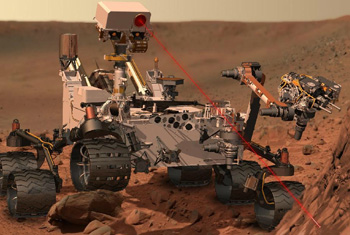The Mars Science Laboratory Curiosity rover ChemCam team members have obtained the initial photos from the remote micro imager on the ChemCam instrument. The first 10 photos were successfully captured by ChemCam and this will allow the scientists to arrange the first test bursts of the system’s rock-zapping laser in the future.
 ChemCam system
ChemCam system
Roger Wiens, a planetary scientist from Los Alamos National Laboratory who is the ChemCam Team's Principal Investigator, said that the successful delivery of the photos will enable capture of the first images of rocks in Mars using the ChemCam instrument as well as indicates the first utilization of the instrument’s laser.
The ChemCam instrument’s next tasks will help scientists define the ChemCam system’s integrity and the pointing ability of the rover's mast that supports the laser and telescope of ChemCam. Engineers and scientist from NASA's Mars rover Curiosity mission have chosen the first target of ChemCam, a three-inch rock named N-165 located near the rover. The ChemCam system, mounted on the Curiosity rover, will scan over 12 miles of the Mars’ surface during the time of one Martian year.
On firing of the powerful laser pulse from ChemCam, it targets the power of million light bulbs onto a section, the size of a pinhead and the laser blast vaporizes its target to seven meters away. The resultant flash of bright plasma is seen by the 4.3-inch aperture telescope on the system and the colors of the light are recorded, allowing scientists to decide the elements present in the vaporized material. The ChemCam system contains a high-resolution camera and is designed to take almost 14,000 observations during the mission.